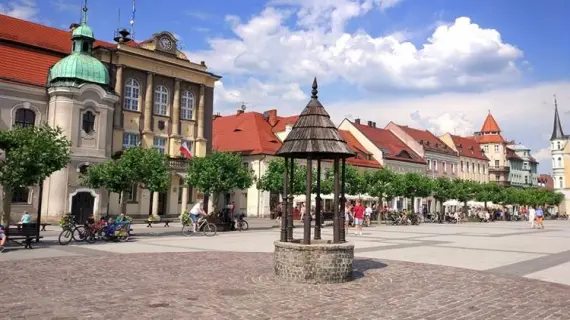Pszczyna - PKS - Buses and Buses - Transportation - Attractions.
PSZCZYNA

Pszczyna is a city in the Silesian province with a population of about 25,000. The city's name is "Pless" in German. It was first mentioned in 1303, although a stronghold must have existed here earlier, guarding the trade route from Krakow to the Moravian Gate.
Pszczyna was ruled by various rulers over the centuries - until the 16th century the local lands belonged to the Piasts, while from 1517 they became part of the German Reich as the Pszczyna state. Of the various families, the Promnitz and Hochberg families had the greatest influence on the town and castle. Despite being officially part of Germany, most of Pszczyna's residents were Polish-speaking, which was most significant during the Silesian uprisings of 1919-1921 and during the Silesian plebiscite.
Pszczyna - city attractions
What to see in the city called the pearl of Upper Silesia? There is much to choose from... Below are the most interesting monuments and attractions of Pszczyna.
Market square in Pszczyna
The market square, with a medieval urban layout, is surrounded by 18th and 19th century townhouses. One of the oldest, whose first floor still remembers 1658, houses the town hall. Right next door you can admire the neo-Baroque building of the Evangelical Augsburg Church. A characteristic point in the market is the bench of Princess Daisy, or the English aristocrat Maria Teresa Hochberg von Pless, who in 1891 married the owner of the Pszczyna castle, John Henry XV.
Pszczyna Castle Museum and Pszczyna Park
The origins of the Pszczyna palace date back to the 11th or 12th century, when the Piast princes established a watchtower and a hunting castle at the site. A brick castle existed in the city since the first half of the 15th century, and has undergone various reconstructions many times since then, along with changes in its owners. The last one took place in 1870-1876. The interiors largely have the original furnishings and furniture belonging to its last inhabitants. While visiting the place, it is also worth going down to the basement, where there is an Armory with interesting exhibitions of European and Oriental weaponry.
The palace complex also includes beautiful ducal stables from the second half of the 19th century and the Gate of the Chosen, a castle guard building from 1687 with an entrance leading to the castle courtyard. The gate owes its name to the selection of its guards from among the peasants in the villages subordinate to the dukedom. The palace is surrounded by a historic park with a total area of 156 hectares, part of which is allocated to the Castle Park with its ponds, canals, historic buildings and diverse vegetation, and the rest to Zwierzyniec Park and Station Park. In Castle Park, the most popular is a small island with a 19th-century tea pavilion.
The bison show enclosure
In 1865 Prince John Henry XI Hohenberg received 4 bison from Bialowieza from Tsar Alexander for 20 deer. Over time, the breeding grew so that after World War I, even the Bialowieza herd was renewed thanks to it. Today, in the show enclosure, the bison can be observed from a viewing platform. In addition, fallow deer, mouflons, deer, roe deer, rabbits or peacocks also live there, and educational workshops and nature lessons for children are held there.
Zagroda Wsi Pszczyńska
This open-air museum is located on the grounds of the Station Park. It consists of several 18th- and 19th-century wooden cottages and farm buildings from the Pszczyna area and its surroundings.
Church of All Saints and Our Lady of the Rosary in Pszczyna
The first information about this most important temple in Pszczyna dates back to 1326. The present Late Baroque building, dating from 1754, has been rebuilt several times over the past centuries. Inside, attention is especially drawn to the beautiful vaulting and chandeliers, as well as the 18th century altar. To the left is a painting of the Virgin Mary of the Precious (Pszczyna).
Museum of the Silesian Press
The Wojciech Korfanty Museum of the Silesian Press is located in a small building from the turn of the 18th and 19th centuries. Between 1845 and 1846, the first Polish-language newspaper in Upper Silesia - "Tygodnik Polski Poścony Włościanom" - was published in the town. The museum collects old printing presses, bookbinding equipment and a sizable collection of Polish newspapers. It also houses the original furnishings of Wojciech Korfanty's study and a collection of musical instruments from Upper Silesia.
Jewish cemetery in Pszczyna
The cemetery was established in 1814. It was not destroyed during World War II, thanks to which more than 400 tombstones and a neo-Gothic pre-burial house can be seen there today.
PSZCZYNA - list of coach stops:
- Tymczasowe Centrum Przesiadkowe, ul.Sokoła, stan.4
- UL. Władysława Broniewskiego 1(Lidl)
- ul.Górnoslaska 42
- Parking BP Globus, ul. Nałkowskiej 17
SINDBAD coach stop:
Stops of other carriers:
PSZCZYNA - list of international connections:
© 2025 Sindbad
Technical support, assistance, payments: Sindbad IT
© 2025 Sindbad
Technical support, assistance, payments: Sindbad IT
